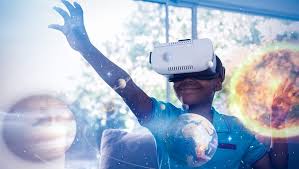
Augmented Reality in Education: Learning Through Your Lens
Imagine pointing your smartphone or smart glasses at a textbook and watching images spring to life in 3D, or exploring the solar system by simply walking around your classroom. This is the magic of Augmented Reality (AR) in education—an innovative technology transforming how students learn by blending digital content with the real world.
Let’s explore how AR is reshaping education, making learning more immersive, interactive, and impactful.
🌟 What Is Augmented Reality?
Augmented Reality overlays digital information—like images, sounds, or 3D models—onto the physical world through devices such as smartphones, tablets, or AR glasses.
Unlike Virtual Reality, which creates a completely artificial environment, AR enhances your real surroundings by adding interactive layers of information.
In education, this means students don’t just read or listen—they experience concepts firsthand.
🎓 How AR Enhances Learning
AR offers several benefits that traditional classrooms often lack:
-
Engagement: Interactive 3D models and animations capture attention and stimulate curiosity.
-
Hands-on Learning: Students can manipulate virtual objects, improving understanding of complex topics.
-
Accessibility: AR can simplify abstract subjects like anatomy, physics, or history by making them visual and tangible.
-
Personalized Pace: Learners can explore AR content at their own speed, repeating or skipping sections as needed.
-
Collaborative Learning: AR apps allow students to work together in shared augmented spaces, fostering teamwork.
🔬 Real-World Applications in Education
-
Science: Visualizing molecular structures, dissecting virtual frogs, or simulating chemical reactions without lab hazards.
-
History: Bringing historical sites and artifacts to life in 3D, letting students “walk through” ancient ruins.
-
Math: Visualizing geometry problems in 3D space, enhancing spatial reasoning.
-
Language Learning: Interactive vocabulary games that place words in real-world contexts.
-
Special Education: Customizable AR tools help students with learning disabilities engage better.
📱 Popular AR Educational Tools
-
Google Expeditions: Virtual field trips using AR and VR.
-
Anatomy 4D: Detailed 3D models of human anatomy.
-
QuiverVision: Coloring pages that come alive with animations.
-
Merge Cube: A handheld device that displays 3D objects through AR apps.
These tools are increasingly affordable and easy to integrate into classrooms and homes.
⚠️ Challenges and Considerations
While promising, AR in education faces hurdles:
-
Cost: Hardware and software can be expensive for some schools.
-
Technical Skills: Teachers need training to effectively use AR tools.
-
Distraction Risk: Overuse might lead to reduced focus on foundational skills.
-
Equity: Not all students have equal access to AR technology.
Addressing these challenges is key to maximizing AR’s potential.
🔮 The Future of AR in Learning
As AR tech advances, expect even more personalized and immersive experiences:
-
AI-powered tutors that adapt AR lessons to individual needs.
-
Mixed reality classrooms blending physical and virtual learning.
-
Real-time language translation layered into AR environments.
-
Collaborative global learning with students interacting across continents via AR.
🧠 Final Thought
Augmented Reality is revolutionizing education by turning passive learning into an active adventure—right through your lens. By making abstract concepts tangible and engaging, AR empowers learners of all ages to explore, experiment, and excel.
As technology becomes more accessible, AR’s role in education will only grow, opening doors to knowledge in ways we once only dreamed possible.